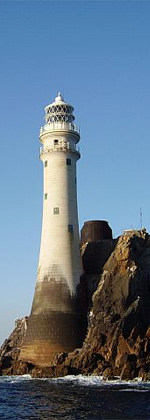Lighthouse
 Spit Bank Lighthouse viewed from Cobh Spit Bank Lighthouse viewed from Cobh | |
| Location | Cork Harbour, Ireland |
|---|---|
| Coordinates | 51°50′43″N 8°16′26″W / 51.84528°N 8.27389°W / 51.84528; -8.27389 |
| Tower | |
| Constructed | 1851 (1851) |
| Foundation | Screw-pile |
| Construction | Cast-iron, metal-plate |
| Shape | Octagonal |
| Markings | White (house), red (platform/piles) |
| Operator | Cork Harbour Commissioners |
| Fog signal | Horn |
| Light | |
| First lit | 1853 |
| Focal height | 10 metres (33 ft) |
| Range | 10 nmi (19 km; 12 mi) (white), 7 nmi (13 km; 8.1 mi) (red) |
| Characteristic | Fl.(2) |
The Spit Bank Lighthouse close to Cobh in County Cork, Ireland is a screw-pile lighthouse which marks a shallow bank in the navigable channels of lower Cork Harbour. The platform was built by the blind Irish engineer Alexander Mitchell (who pioneered the screw-pile technology used), with the lighthouse itself designed by George Halpin. In use since its completion between 1851 and 1853, and renovated as recently as 2013, the landmark structure marks the boundary of compulsory pilotage for large vessels entering the Port of Cork.
Design and construction
Though Irish engineer Alexander Mitchell went blind in 1802 (before he turned 23), he patented the screw-pile mooring in 1833, and built the first screw-pile lighthouses in 1838. These lighthouses included the Maplin Sands Light (1838) and Wyre Light (1839) in England.
Based from Belfast, Mitchell moved to Cobh (then called Queenstown) in 1851 to supervise the foundation works for a lighthouse on the Spit Bank. Located in a relative shallow between Spike Island and Cove Fort, the lighthouse replaced an unlit buoy which marked a turn required by shipping to follow Cork Harbour's main navigable channel. Despite his blindness, with assistance from his son and grandson, Mitchell reportedly supervised some of the work directly. Contemporary accounts record how he was personally involved in construction of a number of his structures, transiting to the work sites in small boats, crawling on planks and examining joints by touch. While living in the area, he also befriended logician George Boole – who was based at Cork's university.
The structure's platform is supported by nine cast-iron screwpiles 60 centimetres (2.0 ft) in diameter and driven approximately 5.2 metres (17 ft) into the sea-bed. The main light and octagonal sheet-iron lighthouse was designed by the engineer to the Commissioners of Irish Lights, George Halpin. With the foundation work laid relatively quickly, the lighthouse was first lit in 1853.
Operation
 Spit Bank under repair in 2013
Spit Bank under repair in 2013
Located less than a half-mile from shore, and with no permanent accommodation, the light was managed by keepers who transited from the nearby town of Cobh. A foghorn was added in the late 19th century, and the light updated and automated in the 20th century. In use for more than 150 years, and one of only three remaining screw-pile lighthouses in Ireland, it was repaired following a collision in 1978, and renovated in 2013.
As of 2016 it remained a working light, with a focal plane of 10 metres (33 ft) and white and red light lenses – depending on direction of approach. The Port of Cork uses the Spit Bank Lighthouse as a boundary marker for the compulsory pilotage of large vessels entering the middle harbour.
See also
References

- ^ Jim Blaney (June 2006). "Alexander Mitchell (1780–1868): Belfast's blind engineer". History Ireland. 14 (3). Retrieved 23 February 2016.
- The Repertory of Patent Inventions, And Other Discoveries and Improvements in Arts, Manufacturers, and Agriculture, July–December 1847. Repertory of Arts and Manufacturers. 1948. p. 116.
- The Repertory of Patent Inventions, And Other Discoveries and Improvements in Arts, Manufacturers, and Agriculture, July–December 1847. Repertory of Arts and Manufacturers. 1948. p. 118.
- ^ "Building of the Month – November 2009 - Spit Bank Lighthouse, Cobh, County Cork". Buildings of Ireland: National Inventory of Architectural Heritage. November 2009. Retrieved 23 February 2016.
- ^ Jane Wales (April 2010). "Spitbank Lighthouse". History Ireland. 18 (2). Retrieved 23 February 2016.
- Shea Tomkins (13 October 2015). "The Blind Irish Engineer who Designed Lighthouses". Ireland's Own. Archived from the original on 6 March 2016. Retrieved 23 February 2016.
- ^ "Spit Bank Lighthouse, Cobh, Cork Harbour Undergoes Maintenance Work". Afloat.ie. 10 September 2013. Retrieved 23 February 2016.
- George Henry Saunders (1855). Mitchell's patent screw piles and moorings, and their applications. Offices of the Screw-Pile and Mooring Co. Retrieved 23 February 2016.
- ^ "County Cork, Spit Bank Lighthouse". Dictionary of Irish Architects. Retrieved 23 February 2016.
- Royal Commission on Lights, Buoys, and Beacons (1861). Report of the commissioners appointed to inquire into the condition and management of lights, buoys and beacons. G.E. Eyre & Spottiswoode. Retrieved 23 February 2016.
{{cite book}}: CS1 maint: multiple names: authors list (link) - "Miscellanea – Queenstown Harbour". The Builder, Volume 9. 1851. Retrieved 23 February 2016.
- ^ Rowlett, Russ. "Lighthouses of Southwestern Ireland (Munster)". The Lighthouse Directory. University of North Carolina at Chapel Hill. Retrieved 23 February 2016.
- "Spitbank Lighthouse under repair". September 2013.
- R. Ingram-Brown (1998). Brown's Nautical Almanac: Daily Tide Tables. Brown, Son & Ferguson. Retrieved 23 February 2016.
- "Passage West and Monkstown, Cork Harbour". Passagewestmonkstown.ie. Archived from the original on 22 May 2015. Retrieved 23 February 2016.
- "Port Of Cork – Notice to Mariners". PortofCork.ie (Google Cache Archive). Retrieved 23 February 2016.
- Eugenio Ribera, José (1895). Puentes de hierro económicos, muelles y faros sobre palizadas y pilotes mecánicos. Madrid: Librería Editorial de Bailly-Bailliere e Hijos. pp. 299 (Lámina XIII).
| Cork Harbour | |||||||
|---|---|---|---|---|---|---|---|
| Settlements |  | ||||||
| Harbour islands | |||||||
| Industry and economy | |||||||
| Navigation |
| ||||||
| Naval and military |
| ||||||
| See also: Coastal fortifications of County Cork | |||||||
